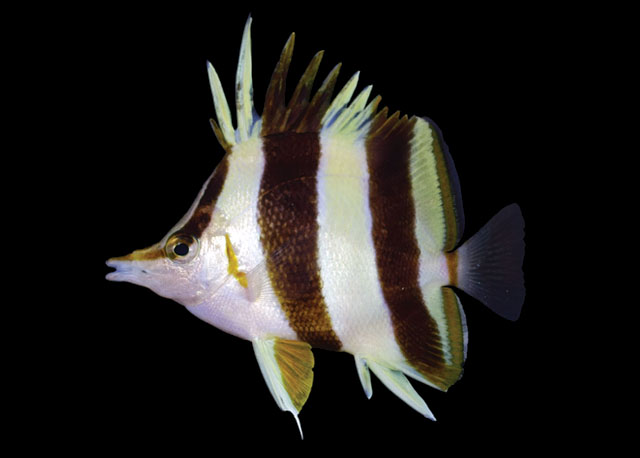| Chaetodontidae (Butterflyfishes) |
| 10.63 cm SL (male/unsexed); 9.34 cm SL (female) |
|
demersal; marine; depth range 45 - 187 m |
| Eastern Central Pacific: Hawaii. |
|
Dorsal spines (total): 12-13; Dorsal soft rays (total): 21-22; Anal spines: 3-3; Anal soft rays: 16-17. This species is distinguished by the following set of characters: D XII-XIII,21-22; A III,16-17; head 2.63-2.80 in SL; body depth 1.58-1.69 in SL; pelvic-fin spine length 3.63-4.07 in SL; colour in life is pale yellow dorsally, fading to white ventrally (sometimes it is entirely white), 3 black bands with narrow white margins on each side of the body, with the first band originating at and including the first dorsal-fin spine, extending diagonally to the eye and continuing horizontally as an orangish brown stripe from the eye to the tip of the snout, while the second band originate at and including the fourth to sixth dorsal-fin spines, extending vertically at a slightly posterior angle to the ventral surface of the abdomen just anterior to the anus, tapering slightly and curving slightly posteriorly below the pectoral fin, and the last or third band originating at and including the last four to five dorsal-fin spines and first four to five dorsal-fin soft rays, extending vertically at a slightly posterior angle to and including the first several anal-fin soft rays, with a narrow orange band on the dorso-posterior margin of the operculum, extending ventrally the posterior angle of the operculum, an oblong orange spot with some dark pigmentation on the upper one-third of the pectoral-fin axis, pelvic fins white on the spine and anterior one-third of fin, and bright orange on the posterior two-thirds of fin, a bright orange submarginal band with narrow white posterior margin extending along the posterior margins of the soft portions of the dorsal and anal fins, and continuing across the caudal peduncle (Ref. 116690). |
| This species was observed in areas of basalt substrata (e.g., basalt talus, blocky lava, lava tubes and pillows, basalt boulders) and in limestone habitats (primarily limestone holes and ledges). Observed also in the vicinity of an unidentified antipatharian coral, near Cirrhipathes spiralis (Linnaeus), and Antipathes dichotoma Pallas. This species in association with limestone ledges and discontinuities representing ancient shorelines, almost in all cases, the fish were found underneath, inside of, or in close proximity to small undercut overhangs or caves, often swimming upside-down in association with the roof of the overhangs and caves. However, there are no obvious associations with other species, such as antipatharian corals, other corals and sessile invertebrates, or particular fish species; although certain species, such as Odontanthias fuscipinnis (Jenkins, 1901) and the wrasse Bodianus sanguineus (Jordan & Evermann, 1903), these species tend to occupy the same depth and habitat. Collected with hand nets during deep dives using mixed-gas, closedcircuit rebreathers (Ref. 116690). FishBase common name agreed by authors. |
|
Not Evaluated (N.E.) Ref. (130435)
|
| harmless |
Source and more info: www.fishbase.org. For personal, classroom, and other internal use only. Not for publication.
